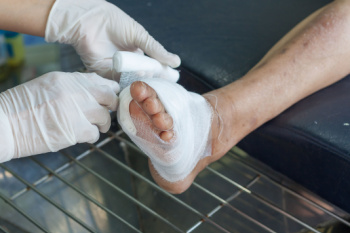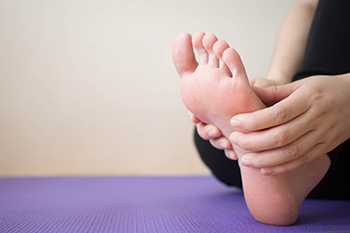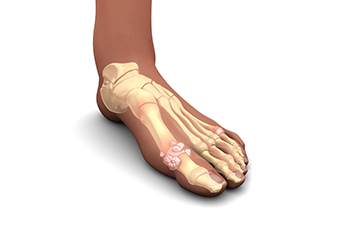Items filtered by date: May 2025
Preventing Diabetic Limb Loss

A chance of limb loss is a serious concern for people with diabetes, as poor blood flow and nerve damage in the feet can cause even minor injuries to become dangerous. When a person cannot feel a cut or sore due to loss of sensation, it may go unnoticed until it becomes infected. Reduced circulation also means these wounds may not heal properly, which increases the risk of tissue death, and, in severe cases, a surgical remedy. A podiatrist plays a key role in preventing loss of limb by performing regular foot exams, monitoring for signs of infection, and treating wounds early. This may involve cleaning the area, removing dead tissue, or surgery to improve blood flow in the legs or feet. Antibiotic treatment may also be required. Identifying problems like swelling, skin color changes, or non-healing ulcers early can help stop the spread of infection. If you are at risk of diabetic limb loss, it is suggested that you schedule regular appointments with a podiatrist for a diagnosis and ongoing treatment.
Diabetic Limb Salvage
Diabetic limb salvage can be an effective way in preventing the need for limb amputation. If you have a foot ulcer and diabetes, consult with Jennifer M. Kern, DPM from South Carolina. Our doctor will assess your condition and provide you with quality foot and ankle treatment.
What Is Diabetic Limb Salvage?
Diabetic limb salvage is the attempt of saving a limb, such as the foot, that has an infected ulcer, from amputation. Podiatrists also try to make sure that there is enough function in the foot after the salvage that it is still usable. Those with diabetes experience poor blood circulation, which prevents proper healing of an ulcer. If the ulcer is left uncheck, it could become infected, which could result in the need for amputation.
Diabetes is the number one cause of non-traumatic amputations in the United States. Amputation has been found to lead to higher mortality rates. This translates into higher healthcare costs, and a reduced quality of life and mobility for amputees. Podiatrists have attempted to increase the prevalence of limb salvage in an attempt to solve these issues.
Diagnosis and Treatment
Limb salvage teams have grown in recent years that utilize a number of different treatments to save the infected limb. This includes podiatrists that specialize in wound care, rehabilitation, orthotics, and surgery. Through a combination of these methods, limb salvage has been found to be an effective treatment for infected limbs, and as an alternative to amputation. Podiatrists will first evaluate the potential for limb salvage and determine if the limb can be saved or must be amputated.
If you have any questions, please feel free to contact our office located in West Columbia, SC . We offer the newest diagnostic and treatment technologies for all your foot care needs.
Why Feet Cramp During Sleep

Foot cramps that strike during sleep can be sudden, painful, and hard to ignore. They often affect the arch or toes and may last just a few seconds or several minutes. These cramps can be caused by dehydration, low mineral levels, poor circulation, or muscle fatigue from daytime activity. Sleeping with feet pointed or in a tight position may also trigger cramping. Stretching your feet and calves before bed, staying well hydrated, and wearing loose socks at night may help prevent episodes. Gently massaging or flexing the foot can ease the pain when a cramp occurs. If cramps become frequent or repeatedly interfere with sleep, it is suggested you see a podiatrist for appropriate treatment.
Foot Pain
Foot pain can be extremely painful and debilitating. If you have a foot pain, consult with Jennifer M. Kern, DPM from South Carolina. Our doctor will assess your condition and provide you with quality foot and ankle treatment.
Causes
Foot pain is a very broad condition that could be caused by one or more ailments. The most common include:
- Bunions
- Hammertoes
- Plantar Fasciitis
- Bone Spurs
- Corns
- Tarsal Tunnel Syndrome
- Ingrown Toenails
- Arthritis (such as Gout, Rheumatoid, and Osteoarthritis)
- Flat Feet
- Injury (from stress fractures, broken toe, foot, ankle, Achilles tendon ruptures, and sprains)
- And more
Diagnosis
To figure out the cause of foot pain, podiatrists utilize several different methods. This can range from simple visual inspections and sensation tests to X-rays and MRI scans. Prior medical history, family medical history, and any recent physical traumatic events will all be taken into consideration for a proper diagnosis.
Treatment
Treatment depends upon the cause of the foot pain. Whether it is resting, staying off the foot, or having surgery; podiatrists have a number of treatment options available for foot pain.
If you have any questions, please feel free to contact our office located in West Columbia, SC . We offer the newest diagnostic and treatment technologies for all your foot care needs.
Why Live with Pain and Numbness in Your Feet?
Excessive Supination Affects Your Foot Health

Supination occurs when the body’s weight is placed along the outside of the foot during walking or running, and excessive supination can lead to strain on the ankles, feet, and toes. People with high arches or inherited structural differences in the legs and feet are more likely to experience excessive supination. It increases the risk of ankle sprains, stress fractures, plantar fasciitis, and other painful foot problems. Wearing improper footwear, poor body alignment, and previous injuries can also contribute to an unstable gait. A podiatrist can diagnose excessive supination by analyzing shoe wear patterns, conducting a gait analysis, and evaluating foot structure. Treatment options include prescribing custom orthotics to support the arch and improve foot alignment. In some cases, surgery may be suggested to correct severe structural problems. Choosing appropriate footwear with cushioning and stability features can also be part of the overall plan. If you have foot pain related to your gait, it is suggested that you schedule an appointment with a podiatrist for appropriate treatment.
If you have any concerns about your feet, contact Jennifer M. Kern, DPM from South Carolina. Our doctor can provide the care you need to keep you pain-free and on your feet.
Biomechanics in Podiatry
Podiatric biomechanics is a particular sector of specialty podiatry with licensed practitioners who are trained to diagnose and treat conditions affecting the foot, ankle and lower leg. Biomechanics deals with the forces that act against the body, causing an interference with the biological structures. It focuses on the movement of the ankle, the foot and the forces that interact with them.
A History of Biomechanics
- Biomechanics dates back to the BC era in Egypt where evidence of professional foot care has been recorded.
- In 1974, biomechanics gained a higher profile from the studies of Merton Root, who claimed that by changing or controlling the forces between the ankle and the foot, corrections or conditions could be implemented to gain strength and coordination in the area.
Modern technological improvements are based on past theories and therapeutic processes that provide a better understanding of podiatric concepts for biomechanics. Computers can provide accurate information about the forces and patterns of the feet and lower legs.
Understanding biomechanics of the feet can help improve and eliminate pain, stopping further stress to the foot.
If you have any questions please feel free to contact our office located in West Columbia, SC . We offer the newest diagnostic and treatment technologies for all your foot and ankle needs.
Definition and First Signs of Gout

Gout is a form of inflammatory arthritis caused by the buildup of uric acid crystals in the joints. This buildup results from either overproduction of uric acid or the body’s inability to eliminate it properly. The condition often affects the big toe joint but can occur in other joints such as the ankles, knees, and wrists. The first sign of gout is usually sudden, intense pain in the affected joint, often starting at night. The joint may appear red, swollen, warm, and extremely tender to the touch. Even the light pressure from a bedsheet can be painful. Repeated gout attacks may lead to chronic joint damage if left untreated. If you have symptoms of gout, it is strongly suggested that you are under the care of a podiatrist who can help you to manage this painful condition.
Gout is a foot condition that requires certain treatment and care. If you are seeking treatment, contact Jennifer M. Kern, DPM from South Carolina. Our doctor will treat your foot and ankle needs.
What Is Gout?
Gout is a type of arthritis caused by a buildup of uric acid in the bloodstream. It often develops in the foot, especially the big toe area, although it can manifest in other parts of the body as well. Gout can make walking and standing very painful and is especially common in diabetics and the obese.
People typically get gout because of a poor diet. Genetic predisposition is also a factor. The children of parents who have had gout frequently have a chance of developing it themselves.
Gout can easily be identified by redness and inflammation of the big toe and the surrounding areas of the foot. Other symptoms include extreme fatigue, joint pain, and running high fevers. Sometimes corticosteroid drugs can be prescribed to treat gout, but the best way to combat this disease is to get more exercise and eat a better diet.
If you have any questions please feel free to contact our office located in West Columbia, SC . We offer the newest diagnostic and treatment technologies for all your foot and ankle needs.




